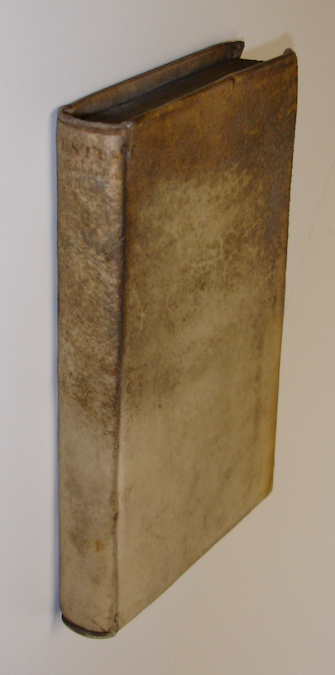FESTUS & M. VERRIUS FLACCUS. Sexti Pompei Festi De verborum significatione fragmentum. Ex vetustissimo exemplari Bibliothecae Farnesianae descriptum. Schedae quae Festi fragmento detractae apud Pomponium Laetum extabant. Ex bibliotheca Fulvi Ursini. Notae in Sex. Pompei Festi fragmentum, schedas & epitomam. (Genève), apud Petrum Santandreanum, 1583.
8vo. (1),196,(18),62 p. Vellum 17 cm (
Ref: 1 GLN 3005; Schweiger 2,354, Smitskamp 60) (
Details: Six thongs laced through the joints. Veritas printer's device on the title: a woman, the naked truth, seated on a cubus, holding a radiant sun in her right hand; in her left hand she holds an opened book and a palm leaf; her feet rest on the globe; the garland of fruit which surrounds her shows a ribbon with the text in Greek: 'Alêtheia Pandamatôr', i.e. 'Allmighty Truth'). (
Condition: Vellum partly soiled. Right margin of title slightly thumbed; title slightly browning) (
Note: Festus is a 2nd century grammarian, who produced an abbreviation of a lexicographic work by Marcus Verrius Flaccus, a wellknown antiquarian and grammarian living in Augustan Rome. Verrius compiled an enormous lexicon in 80 books, full of unusual, difficult, and archaic words, with discussions about customs, political institutions, belief and Roman law. Remains of his work survive in the epitome of 20 books made by Sextus Pompeius Festus. Festus also added examples found in other sources; the original work of Verrius is completely lost, and only 1 manuscript of Festus survived the Middle Ages in an heavily mutilated form. The first reliable text, which was a great improvement compared to earlier editions was published in 1559 by Antonio Agustin, 1517-1586, who made good use of the Farnese manuscript at Naples, and aimed at reconstructing the text in a strict alphabetical order from A to V, with the help of other Medieval epitomes of Festus. GLN 15-16 states that this edition is a reissue of an edition published in 1581 in Rome. According to Smitskamp 60 Fulvius Ursinus simply reproduces Scaliger's edition without mentioning his name. In the praefatio to the 62 pages with learned notes the reader is assured that this edition (of 1583) is a faithful transcription of the sole surviving MS of Festus) (
Collation: A-N8, O4; A-C8, D8 (minus leaf D8) (Photographs on request)
Book number: 120331 Euro 500.00
Keywords: (Oude Druk), (Rare Books), Festus, Lexikographie, Lexikon, Swiss imprints, Verrius Flaccus, lexicography, lexicon
 FESTUS & M. VERRIUS FLACCUS.
FESTUS & M. VERRIUS FLACCUS.